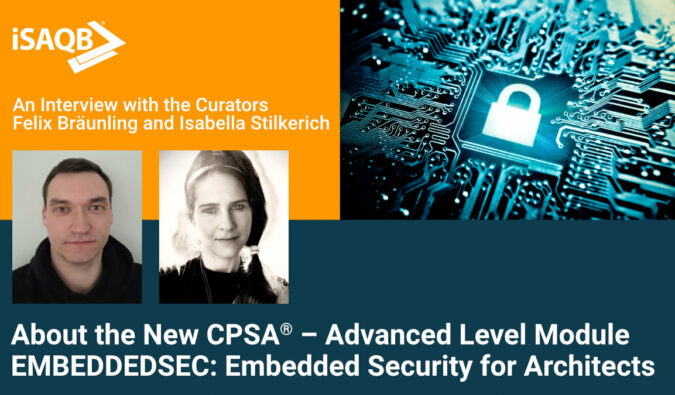About the New CPSA® – Advanced Level Module EMBEDDEDSEC: Embedded Security for Architects
An Interview with the Curators Felix Bräunling and Isabella Stilkerich
On November 19, 2025, the iSAQB introduced the new Advanced Level module “EMBEDDEDSEC: Embedded Security for Architects”.
The module EMBEDDEDSEC provides participants with methods for designing an embedded system architecture that reflects their security goals. Building on the concepts of the Foundation Level, the module introduces participants to analysis methods for identifying protection-worthy assets and deriving security goals for embedded systems. It presents qualities, design patterns, and technologies that help in achieving security goals and familiarize participants with common attack patterns.
Finally, techniques for verifying and validating security properties are presented. At the end of the module, participants know approaches to designing embedded architectures with security as a quality in mind and are able to identify security risks and select suitable control measures.
We conducted an interview with the curators, Felix Bräunling and Isabella Stilkerich, where they provide deeper insights into the module.
Why did the iSAQB decide to develop a dedicated Advanced-Level module on Embedded Security?
Embedded devices are at the heart of our everyday lives – whether in consumer electronics, smart home systems, or critical applications such as medical or automotive technology. Their secure operation protects the privacy and physical safety of their users. However, security cannot simply be added to a system afterwards; it must be considered from the very beginning. We often refer to this as Security by Design.
For software architects, it is therefore essential to understand how security risks can be identified and appropriately mitigated. This is exactly what trainings based on the EMBEDDEDSEC curriculum aim to achieve.
What are the key differences between Embedded Security and classic IT Security?
Depending on the degree of embedding, boundaries between the two domains increasingly blur – for instance in the high-performance controllers of in-vehicle infotainment systems. Yet important differences remain, regardless of system size: limited resources, specialized or proprietary interfaces, restricted user interfaces, and in some cases very limited or no internet connectivity. Embedded systems are also designed for a specific purpose and optimized solely for fulfilling that purpose.
These characteristics require adapted solutions, such as resource-efficient encryption mechanisms, user-independent authentication methods, or secure and resilient update strategies.
Particularly in safety-critical embedded systems, it must be ensured that attackers cannot harm users. This means that security goals like availability often receive higher priority than confidentiality – contrary to classic IT security. In emergency scenarios, for example, a medical system must remain available, even if a complex authentication process would otherwise delay its use.
Why is the connection between Functional Safety and Security especially important in embedded systems?
By definition, embedded systems are integrated into their environment and directly influence it – often in sensitive areas of our lives. This ranges from controlling an industrial robot to a vacuum-cleaning robot equipped with a camera. Attacks on such systems can therefore compromise both privacy and the physical safety of individuals.
Functional Safety and Security often complement each other and can work together to prevent such scenarios. However, conflicts between the two can arise: Typical security mechanisms such as access control or encryption may conflict with functional safety requirements, for example when very high availability or strict real-time constraints must be met.
For this reason, it is essential to consider both aspects and their interactions. Balancing them in accordance with quality requirements is a central part of architectural work.
What typical security risks occur in embedded systems, and how does the module help participants identify and assess them?
Typical security risks often resemble those of conventional IT systems. The OWASP IoT Top 10, for example, lists “weak, guessable, or hardcoded passwords” or the “use of insecure or outdated components.” Embedded systems also add the physical dimension: hardware must be hardened against attacks such as side-channel attacks, glitching, and other forms of manipulation.
In addition, embedded systems are frequently developed in C or C++—languages known for high performance but limited guarantees regarding memory and type safety. Many vulnerabilities arise precisely at this point.
The training therefore covers not only common attack types, but also physical attacks, secure implementation techniques, and modern alternatives to C/C++, such as Rust.
A key component is a systematic approach to identifying risks – the foundation for all further security measures.
The curriculum also covers cryptography and hardware aspects. What competencies do participants gain in these areas?
The module does not aim to provide a complete education in implementing cryptography. Instead, participants learn to understand fundamental operations and assess which cryptographic mechanism suits which security objective – for example, why not every form of encryption ensures data integrity, or why update signatures are essential. Participants also receive an overview of recommended algorithms, including those specifically designed for resource-constrained systems.
Regarding hardware aspects, the focus is not on building hardware from scratch but on understanding typical physical attacks and common hardware security mechanisms such as Physical Unclonable Functions, redundancies, or Hardware Security Modules. Especially in embedded systems, security often emerges from the interplay between hardware and software.
What should participants be able to apply in practice after completing the EMBEDDEDSEC module—and what value does this add to their work as software architects?
After completing the module, participants should be able to analyze an initial system design for potential security risks, assess those risks, select appropriate countermeasures, and adapt them to the functional and quality requirements of the system.
They will also learn the fundamentals of verification and validation techniques in security, enabling them to support testers and assess a system’s testability. This equips them to design embedded systems with greater security in mind – without losing sight of other architectural qualities.
In addition, based on the methods and references provided, they will be able to expand their knowledge independently.
Share this article:
Related Posts
No related articles found




